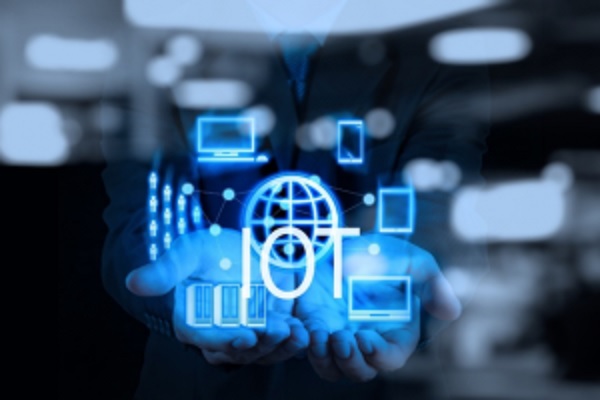The Internet of Things (IoT) is increasingly present in our daily lives, at work, in the home and in the public sphere, making the world a more connected place. In fact, 2020 will see at least 20 billion connected devices across the globe.
So, let's take a look at the most common iterations of the IoT at the moment, and what we can expect to see in the IoT landscape over the next 5 years.

How IoT looks now
In Our Homes
Many people's first experience of the IoT comes from their domestic life. There are hundreds of connected devices available to buy without breaking the household budget, from Google's Assistant software to smart "Nest" thermostats. People can use their voices to control their surroundings, making their homes and lives more connected than ever before. Smart homes also give us extra peace of mind, as IoT-enabled tech can connect owners to their home at all times.
On Our Wrists
Thanks to wearable technology, more people are starting to carry IoT capability around with them. Smartwatches like the Apple Watch mean our wrists are now synched with mobile devices and associated services. Additionally, the proliferation of wearable fitness trackers such as Fitbit, which provide instant data about users' workouts, has changed the face of the wider fitness space.
The world of work is changing to accommodate wearable IoT devices too. Employers are now introducing wearables into the office and onsite workplaces, allowing remote information sharing and optimization of employee processes.
What can we expect over the next five years?
In Our Cities
As IoT tech is adopted within the home, we'll also begin to see its application in wider urban neighborhoods, towns and cities. "Smart cities" will streamline services and improve infrastructure – provided they have the right connections and data. Issues like traffic congestion and pollution are among the problems the IoT can solve when smart technology is built into a city. Early schemes are already at work in Barcelona and Southampton, UK – other cities are sure to follow suit with innovative and smart technology over the next few years.
On Our Roads
Most high-end cars being sold today already have a high degree of connectivity, and the automotive industry is not going to slow down in delivering optimal user experience and embracing the IoT. Car manufacturers over the next five years will drive a revolution in how people both buy and use their vehicles. Increased accessibility will mean you can adjust car temperature, check mileage, or even start the ignition from an app. Also, with more control over cars at all times, users will benefit from better security.
The IoT is transforming every day physical objects like phones, watches and cars and creating an ecosystem of information that will enrich our lives. As more and more things enter into the digital fold, the IoT is en route to becoming the defining disruptive technology of our time.
The Latest
The use of hybrid multicloud models is forecasted to double over the next one to three years as IT decision makers are facing new pressures to modernize IT infrastructures because of drivers like AI, security, and sustainability, according to the Enterprise Cloud Index (ECI) report from Nutanix ...
Over the last 20 years Digital Employee Experience has become a necessity for companies committed to digital transformation and improving IT experiences. In fact, by 2025, more than 50% of IT organizations will use digital employee experience to prioritize and measure digital initiative success ...
While most companies are now deploying cloud-based technologies, the 2024 Secure Cloud Networking Field Report from Aviatrix found that there is a silent struggle to maximize value from those investments. Many of the challenges organizations have faced over the past several years have evolved, but continue today ...
In our latest research, Cisco's The App Attention Index 2023: Beware the Application Generation, 62% of consumers report their expectations for digital experiences are far higher than they were two years ago, and 64% state they are less forgiving of poor digital services than they were just 12 months ago ...
In MEAN TIME TO INSIGHT Episode 5, Shamus McGillicuddy, VP of Research, Network Infrastructure and Operations, at EMA discusses the network source of truth ...
A vast majority (89%) of organizations have rapidly expanded their technology in the past few years and three quarters (76%) say it's brought with it increased "chaos" that they have to manage, according to Situation Report 2024: Managing Technology Chaos from Software AG ...
In 2024 the number one challenge facing IT teams is a lack of skilled workers, and many are turning to automation as an answer, according to IT Trends: 2024 Industry Report ...
Organizations are continuing to embrace multicloud environments and cloud-native architectures to enable rapid transformation and deliver secure innovation. However, despite the speed, scale, and agility enabled by these modern cloud ecosystems, organizations are struggling to manage the explosion of data they create, according to The state of observability 2024: Overcoming complexity through AI-driven analytics and automation strategies, a report from Dynatrace ...
Organizations recognize the value of observability, but only 10% of them are actually practicing full observability of their applications and infrastructure. This is among the key findings from the recently completed Logz.io 2024 Observability Pulse Survey and Report ...
Businesses must adopt a comprehensive Internet Performance Monitoring (IPM) strategy, says Enterprise Management Associates (EMA), a leading IT analyst research firm. This strategy is crucial to bridge the significant observability gap within today's complex IT infrastructures. The recommendation is particularly timely, given that 99% of enterprises are expanding their use of the Internet as a primary connectivity conduit while facing challenges due to the inefficiency of multiple, disjointed monitoring tools, according to Modern Enterprises Must Boost Observability with Internet Performance Monitoring, a new report from EMA and Catchpoint ...






